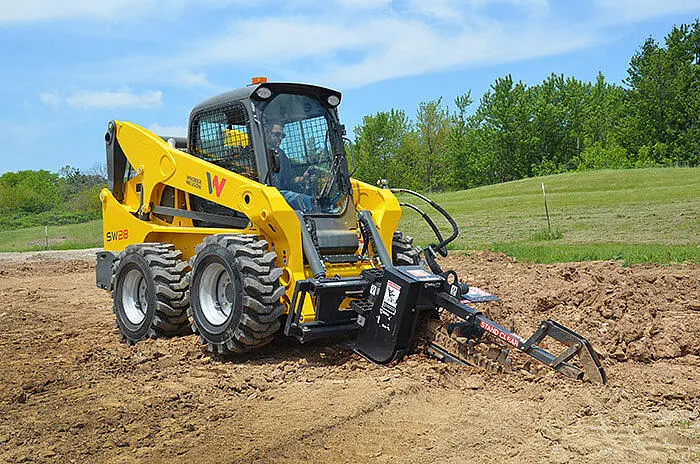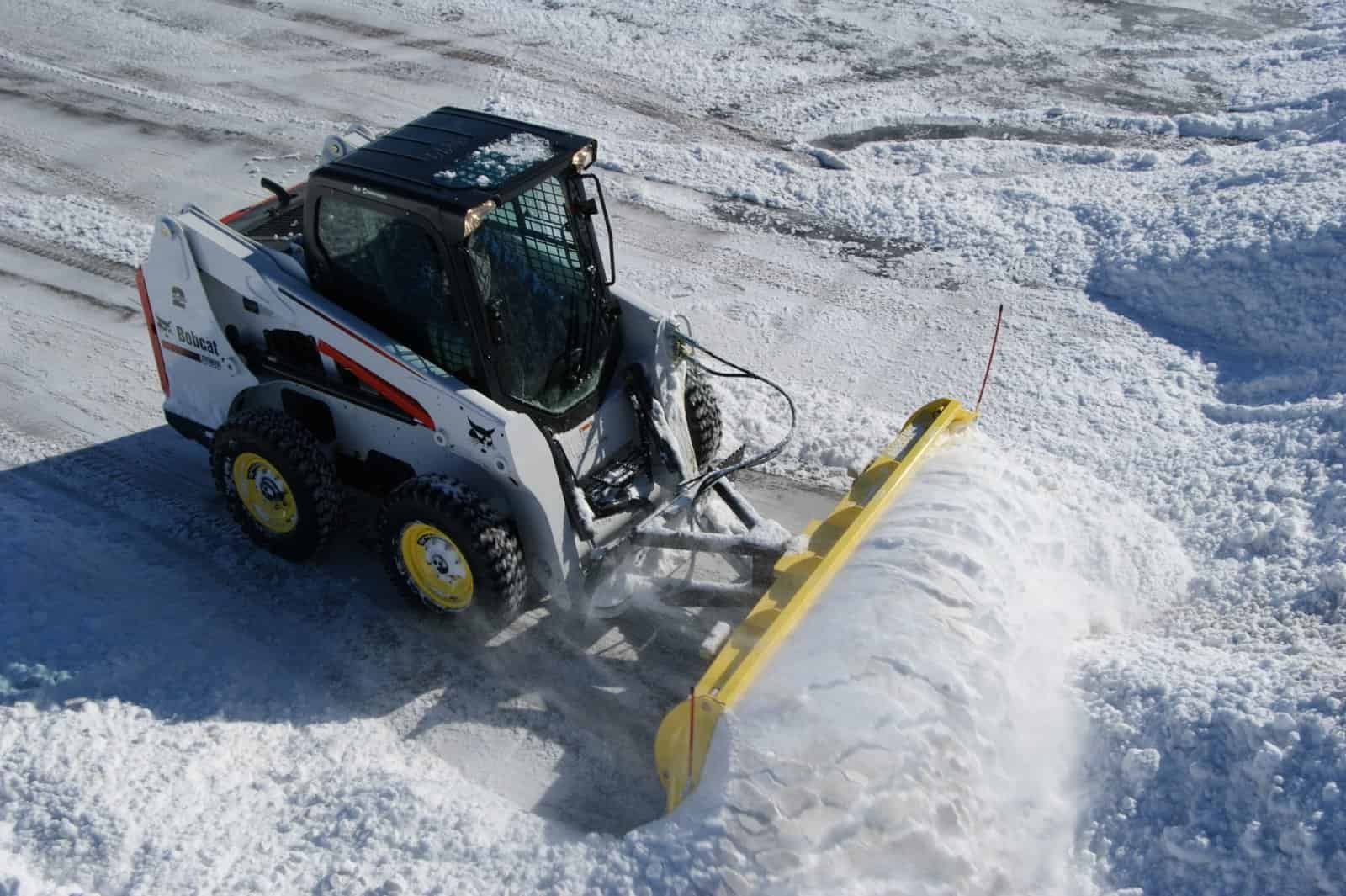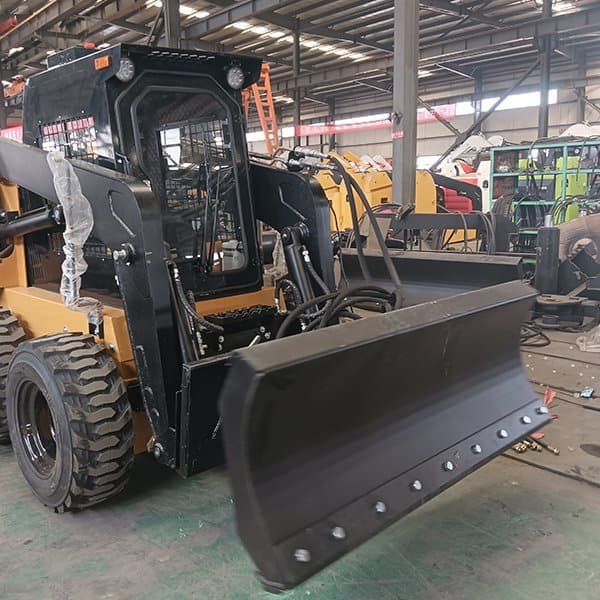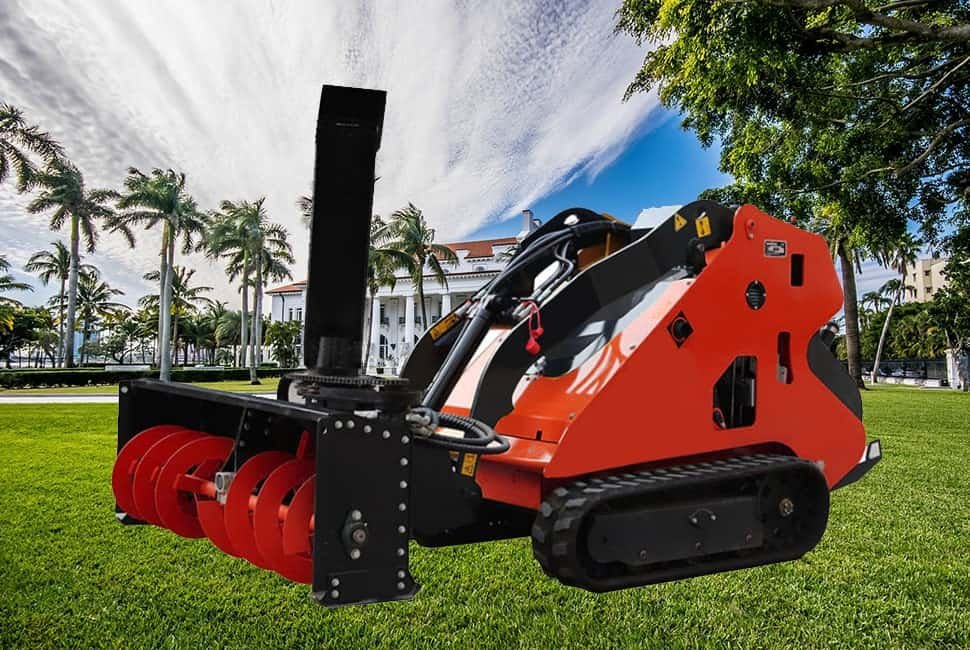Looking for a clear skid steer definition but keep finding vague explanations? Many people struggle to understand what makes a skid steer unique. Don’t worry—this guide will break it down for you in a simple and practical way.
Skid Steer Definition
A skid steer is a compact, engine-powered machine with lift arms designed to attach various tools. It operates using a unique “skid-steering” system, where wheels or tracks on each side move at different speeds to turn. This makes it highly maneuverable in tight spaces. Skid steers are widely used in construction, agriculture, landscaping, and snow removal due to their versatility and efficiency.
Want to know more about how a skid steer works, its uses, advantages, and how to choose the right model? Read on to find out!
How does a skid steer work?
Skid steers are a unique type of loader that stands out from traditional loaders due to their distinctive turning mechanism and control system. But how exactly do they operate?
Skid steers achieve their remarkable maneuverability through a skidding motion. The wheels or tracks on one side of the machine move at a different speed than those on the other side. This clever design allows the skid steer to make a zero-degree turn radius, meaning it can pivot around its own center. This eliminates the need for a steering axle, making it incredibly agile in tight job sites and confined spaces.
Unlike other loaders, skid steers do not rely on a traditional steering system. Instead, they are equipped with a dual hydraulic drive system. This advanced technology enables the left and right wheels or tracks to operate at different speeds independently. As a result, skid steers can make sharp, precise pivot turns with ease. This unique capability makes them highly sought after in small construction sites, farms, and landscaping projects, where tight spaces and precise maneuvering are often required.
There are two main types of skid steers: wheeled skid steers and tracked skid steers. Wheeled skid steers are designed for optimal performance on paved or hard surfaces. Their wheels provide excellent traction and speed on firm ground, making them ideal for tasks such as loading and unloading materials on construction sites or in warehouses.

On the other hand, tracked skid steers, also known as compact track loaders, excel in more challenging terrain. Their tracks provide superior traction and stability on soft, muddy, or snowy surfaces. This makes them perfect for tasks such as grading, excavating, and material handling in environments where wheeled loaders would struggle. Whether you need to work on a paved road or a muddy field, there is a skid steer designed to meet your specific needs.
What are the main uses of a skid steer?
Skid steers are incredibly versatile machines, thanks to their powerful performance and wide range of attachments. As a result, they are widely used across many industries.
Skid steers are commonly used for excavation, grading, snow removal, material transport, landscaping, and demolition. Their ability to switch between attachments makes them one of the most versatile machines in construction and agriculture.
1. Construction:
Skid steers are used for digging foundations, moving materials, and site preparation. Their compact size and powerful performance make them ideal for working in tight spaces, while their ability to switch between attachments allows them to tackle a variety of tasks.
2. Agriculture:
Skid steers help with feeding livestock, cleaning barns, and handling heavy loads. Their versatility and power make them an essential tool for farmers, allowing them to complete a wide range of tasks efficiently and effectively.
3. Landscaping:
Skid steers are ideal for grading soil, digging trenches, and planting trees. Their compact size and powerful performance make them perfect for working in tight spaces, while their ability to switch between attachments allows them to tackle a variety of tasks.

4. Snow Removal:
Skid steers equipped with snowblowers or plows can efficiently clear roads and driveways. Their powerful performance and compact size make them ideal for working in tight spaces, while their ability to switch between attachments allows them to tackle a variety of tasks.
5. Demolition:
Skid steers with the right attachment can break concrete and remove debris from job sites. Their powerful performance and compact size make them ideal for working in tight spaces, while their ability to switch between attachments allows them to tackle a variety of tasks.
For those considering a track or wheel skid steer for farm use, wheeled models offer better speed on solid ground, while tracked versions provide stability on soft or muddy fields. Wheeled skid steers are ideal for tasks such as feeding livestock and cleaning barns, while tracked skid steers are better suited for tasks such as handling heavy loads and working in muddy fields.
What is the difference between a skid steer and a compact track loader?
While skid steers and compact track loaders (CTLs) may appear quite similar at first glance, their distinct characteristics significantly influence their performance across different terrains and applications.
The primary distinction between the two lies in their mobility systems. Skid steers are equipped with wheels, which makes them particularly well-suited for paved surfaces, hard-packed ground, and other relatively smooth and stable environments. On the other hand, compact track loaders utilize tracks, granting them superior maneuverability and stability on wet, loose, uneven, or otherwise challenging terrains such as muddy fields, sandy areas, and snowy landscapes.
Let’s delve deeper into the specific differences that set these two types of machines apart:
1. Speed and Efficiency:
Wheeled skid steers generally boast faster travel speeds and greater fuel efficiency. This makes them the go-to choice for tasks that require quick movement and minimal fuel consumption, such as material transport on well-maintained construction sites or in warehouses.
2. Traction:
Compact track loaders truly shine when it comes to traction. Their tracks provide an extensive contact area with the ground, enabling them to maintain a firm grip even in the most slippery conditions like mud, sand, and snow. This enhanced traction is invaluable for tasks such as excavation in wet environments or snow removal in heavy snowfall areas.
3. Maintenance Costs:
It’s important to note that tracks require more regular maintenance than wheels. The complex nature of the track system means that CTLs may incur higher maintenance costs over time. This includes the need for more frequent inspections, adjustments, and potential repairs to ensure optimal performance and longevity.
4. Snow Removal:
When it comes to snow removal, the choice between tracks and wheels depends on the specific conditions. Compact track loaders with snowblower attachments offer unparalleled grip and stability in deep snow or on icy surfaces, allowing for efficient and effective snow clearing. However, wheeled skid steers equipped with plows can also perform well on cleared roads, providing a faster and more fuel-efficient option for post-snowfall cleanup.

The decision between a wheeled skid steer and a compact track loader largely depends on the specific working environment and tasks at hand. For those working primarily in rocky areas, on pavement, or in environments with well-maintained surfaces, wheeled skid steers are the ideal choice due to their speed, efficiency, and lower maintenance costs. Conversely, if your work involves frequent encounters with soft, wet, or uneven ground, a compact track loader is the more effective option, thanks to its superior traction and stability.
What are the advantages of using a skid steer?
Skid steers are among the most versatile compact machines available, providing a multitude of benefits for both construction and agricultural tasks. Their compact size and powerful performance make them indispensable tools in a variety of industries.
The advantages of skid steers are numerous and significant:
1. Compact Design:
Skid steers are designed to work in tight job sites and indoor spaces, making them perfect for tasks in confined areas where larger machines simply can’t fit. Their small footprint allows them to navigate narrow passages and work in close quarters with ease.
2. High Maneuverability:
Thanks to their unique skidding motion, skid steers can make zero-degree turns, allowing them to pivot around their own center. This high maneuverability is particularly valuable in small construction sites, farms, and landscaping projects where precise control is essential.
3. Attachment Versatility:
Skid steers are compatible with a wide range of attachments, including buckets, augers, trenchers, and more. This versatility means that a single skid steer can perform multiple tasks, reducing the need for multiple machines and increasing overall efficiency on the job site.
4. Skid Steer Dozer Blade:
Skid steers can be equipped with a dozer blade, enabling them to perform light dozing and grading tasks. This makes them a cost-effective alternative to larger dozers for smaller-scale earthmoving projects.

5. Lower Purchase Costs:
Compared to larger construction machines, skid steers are more affordable to purchase. This lower cost makes them an attractive option for small businesses and contractors who need a versatile machine without breaking the bank.
6. Easy Transportability:
Skid steers are easy to transport, making them ideal for projects that require frequent relocation. Their compact size and lightweight design allow them to be easily loaded onto trailers and moved from one job site to another.
When comparing a dozer to a skid steer, it’s important to consider the specific needs of your project. While a skid steer offers unparalleled flexibility and versatility, making it suitable for a wide range of tasks in tight spaces, a dozer is better suited for heavy-duty land clearing and large-scale earthmoving projects. The choice between the two ultimately depends on the scope and requirements of your work.
Skid steers are highly versatile machines that offer a compact design, high maneuverability, attachment versatility, lower purchase costs, and easy transportability. They are ideal for small job sites and tight spaces, making them a valuable addition to any construction or agricultural operation. Whether you need to perform excavation, grading, snow removal, or material handling, a skid steer can get the job done efficiently and effectively.
What should you consider when buying a skid steer?
Investing in a skid steer is a substantial decision that requires careful consideration. To ensure you make the best choice, it’s essential to evaluate several key factors.
When selecting a skid steer, consider factors such as engine power, rated operating capacity (ROC), lift height, attachment compatibility, brand reliability, and maintenance costs. Each of these elements plays a crucial role in determining the machine’s performance and longevity.
1. Size Matters:
The size of the skid steer should be tailored to your specific workload and space constraints. A smaller machine may be more maneuverable in tight spaces, while a larger one might offer greater power and capacity for heavier tasks. Assess your job site conditions and the types of tasks you’ll be performing to choose the right size.
2. Power & Performance:
The engine power of a skid steer is critical, especially if you plan to use heavier attachments. High horsepower ensures that the machine can handle demanding tasks without strain, providing consistent performance and reducing the risk of engine overload.
3. Durability & Brand Reputation:
The reliability and durability of a skid steer are paramount. Researching the repair records of popular brands like Bobcat, Case, and Hixen can provide valuable insights into long-term maintenance and potential issues. Understanding the common repair needs and the overall reliability of each brand can help you make an informed decision.
4. Operating Costs:
Beyond the initial purchase price, consider the ongoing operating costs. Compare the fuel efficiency ratings of different brands to understand which machine will offer the best value over time. Additionally, factor in the cost of regular maintenance and potential repairs to get a comprehensive picture of the total cost of ownership.
Understanding the differences between a dozer and a skid steer can also be instrumental in determining if a skid steer is the right choice for your needs. While a dozer excels in heavy-duty land clearing and large-scale earthmoving, a skid steer offers unparalleled versatility and maneuverability, making it suitable for a wide range of tasks in confined spaces.
Purchasing a skid steer involves evaluating several key factors, including machine size, power, durability, brand reputation, and operating costs. By carefully considering these elements, you can make a well-informed decision that aligns with your specific needs and ensures a reliable, efficient, and cost-effective investment.
Summary
A skid steer is a powerful and versatile machine, perfect for construction, agriculture, and landscaping. Understanding its definition, uses, advantages, and purchasing factors ensures you make an informed decision.


